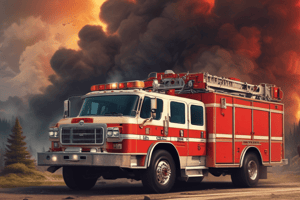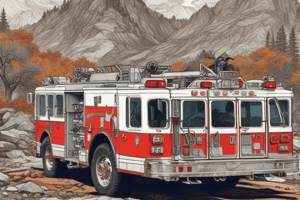Podcast
Questions and Answers
In which situation is shelter-in-place considered the most appropriate option?
In which situation is shelter-in-place considered the most appropriate option?
- When the outside air quality is safe
- When the emergency path is unpredictable (correct)
- When evacuation can be completed within 30 minutes
- When the building is undergoing routine maintenance
What is one of the advantages of shelter-in-place?
What is one of the advantages of shelter-in-place?
- It guarantees safety against all emergencies
- It allows for extensive preparation time
- It provides immediate protection from outside contaminants (correct)
- It requires evacuation to a nearby facility
Which of the following is NOT a factor to consider when deciding on shelter-in-place?
Which of the following is NOT a factor to consider when deciding on shelter-in-place?
- Building integrity and ventilation system
- Availability of emergency kits (correct)
- Type and amount of contaminant
- Duration of the event
What is the first step in the in-place sheltering process?
What is the first step in the in-place sheltering process?
What kind of emergencies is shelter-in-place used for?
What kind of emergencies is shelter-in-place used for?
Which scenario indicates a fire originating in the basement?
Which scenario indicates a fire originating in the basement?
What might unevenly broken windows indicate about a fire situation?
What might unevenly broken windows indicate about a fire situation?
Which of the following is NOT a fire behavior indicator seen from outside?
Which of the following is NOT a fire behavior indicator seen from outside?
In the context of fire situations, what does smoke rising from the eaves suggest?
In the context of fire situations, what does smoke rising from the eaves suggest?
Which part of the house is associated with the highest risk of fire damage based on the diagrams?
Which part of the house is associated with the highest risk of fire damage based on the diagrams?
What is the primary purpose of conducting a secondary search after a fire is controlled?
What is the primary purpose of conducting a secondary search after a fire is controlled?
Why should different personnel conduct the secondary search?
Why should different personnel conduct the secondary search?
What equipment is essential for personnel during a secondary search, regardless of building appearance?
What equipment is essential for personnel during a secondary search, regardless of building appearance?
In the oriented-search method, where does the team leader remain during the search?
In the oriented-search method, where does the team leader remain during the search?
What is a key characteristic of the wide-area search method?
What is a key characteristic of the wide-area search method?
What role does the incident commander (IC) play in the search process?
What role does the incident commander (IC) play in the search process?
How should search teams report their progress to the IC?
How should search teams report their progress to the IC?
What is crucial for the successful coordination of multiple search teams?
What is crucial for the successful coordination of multiple search teams?
What is the primary function of SCBA in exposure protection?
What is the primary function of SCBA in exposure protection?
What is a key consideration when planning a victim removal operation?
What is a key consideration when planning a victim removal operation?
Which protective gear provides the highest level of dermal protection?
Which protective gear provides the highest level of dermal protection?
In a combined space entry, what is a critical action prior to entry?
In a combined space entry, what is a critical action prior to entry?
What is the role of continuous ventilation in a combined space?
What is the role of continuous ventilation in a combined space?
In which zone are personnel allowed direct access without PPE?
In which zone are personnel allowed direct access without PPE?
Why is the assessment of wind direction critical at a hazardous incident?
Why is the assessment of wind direction critical at a hazardous incident?
Which type of air monitoring should be performed continuously in a confined space?
Which type of air monitoring should be performed continuously in a confined space?
What is a primary function of the Exclusion Zone?
What is a primary function of the Exclusion Zone?
How should the decontamination corridor be arranged?
How should the decontamination corridor be arranged?
Which factor is NOT directly assessed when determining the most effective extinguishment method?
Which factor is NOT directly assessed when determining the most effective extinguishment method?
What significant change did the LAFD implement after the 2018 roof collapse incident?
What significant change did the LAFD implement after the 2018 roof collapse incident?
In a direct attack, what is the primary goal of using a solid or straight stream?
In a direct attack, what is the primary goal of using a solid or straight stream?
Which of the following is NOT a factor the Incident Commander must consider when opting for a direct attack?
Which of the following is NOT a factor the Incident Commander must consider when opting for a direct attack?
What does the term 'cyclical' refer to in the context of operational risk management during an incident?
What does the term 'cyclical' refer to in the context of operational risk management during an incident?
Which factor does NOT influence fire spread?
Which factor does NOT influence fire spread?
What is a primary method for protecting exterior exposures during a fire?
What is a primary method for protecting exterior exposures during a fire?
What role does the Incident Commander (IC) play in managing exposure protection?
What role does the Incident Commander (IC) play in managing exposure protection?
Which strategy can help control interior exposures in a building during a fire?
Which strategy can help control interior exposures in a building during a fire?
What is an active means of managing exterior exposures during a fire?
What is an active means of managing exterior exposures during a fire?
Which of the following is NOT a component of fire suppression systems?
Which of the following is NOT a component of fire suppression systems?
What is the purpose of using positive pressure ventilation in interior fire control?
What is the purpose of using positive pressure ventilation in interior fire control?
During a fast-moving ground cover fire, what is the recommended action for personnel?
During a fast-moving ground cover fire, what is the recommended action for personnel?
Which of the following considerations is crucial when determining exposure protection?
Which of the following considerations is crucial when determining exposure protection?
What type of barriers can be used to control fire spread?
What type of barriers can be used to control fire spread?
Flashcards are hidden until you start studying
Study Notes
Search and Rescue Tactics
- Shelter-in-Place: A defensive strategy used when evacuation is impossible, emergency paths are unpredictable, or time is insufficient; applicable during various contaminants or threats.
- Advantages: Protection from external hazards, fast implementation, and stability in familiar surroundings.
- Considerations: Type of contaminant, building integrity, duration of exposure, and local guidelines govern the decision to shelter-in-place.
- Execution Steps: Involves sealing all exits, deactivating ventilation systems, and closing fireplace dampers to minimize outside air entry.
Fire Search Methods
- Primary vs. Secondary Searches: After containing a fire, a secondary search is conducted with fresh personnel, utilizing a systematic approach to locate any remaining occupants.
- Initial Conditions Assessment: The Incident Commander (IC) evaluates the building’s safety before committing crews to secondary searches; personnel must wear self-contained breathing apparatus (SCBA) despite visible smoke.
- Search Techniques:
- Teams maintain communication, and the search must be methodical to avoid missed areas.
- Directing using hoselines ensures safety and support during searches.
Oriented Search Method
- Anchoring Strategy: The team leader anchors to a point while other members spread out to conduct searches in separate rooms, enabling better coordination and communication.
Exterior Exposure Control
- Factors Influencing Fire Spread: Location and size of fires, building construction, vegetation, and proximity of structures.
- Exposure Protection Tactics: Utilize size-up assessments, evacuate dangerous structures, and coordinate ventilation efforts during firefighting to limit exposure risks.
Fire Suppression Operations
- Strategic Fire Attacks:
- Direct Attack: Most effective for fuel-controlled fires, applying water or foam directly to burning areas.
- Indirect Attack: Involves cooling smoke layers and the compartment's linings to suppress fire without direct application.
- Combination Attack: Utilizes both direct and indirect methods concurrently to maximize extinguishment effectiveness.
- Transitional Attack: Begins with controlling visible fire from outside to improve internal conditions before interior firefighting starts.
Cultural Shift in Firefighting Tactics
- 2018 LAFD Incident: Following a roof collapse incident revealing the need for tactical reassessment, LAFD improved operational risk evaluations, integrating an emergency decision-making model.
Personal Protective Equipment (PPE) Considerations
- Types: Level B protection for skin and inhalation hazards; SCBA for maximum respiratory safety in hazardous environments.
- Confined Space Protocols: Continuous monitoring and adequate ventilation are crucial while entering potential confined spaces.
Victim Removal Guidelines
- Prioritize rapid and safe removal of victims from hazardous areas; strategies must be planned meticulously to minimize risk for rescue personnel.
Importance of Wind Direction
- Understanding wind direction is essential during hazardous incidents to determine safe operational approaches and strategies.
Multiple Choice Questions (Sample)
- Focus on the correct interpretation of PPE levels and the use of AP respiratory protection within IDLH environments.
Flying Embers
- Recognize the hazards posed by flying embers which can ignite flammable materials and structures nearby, necessitating vigilant management of fire spread.
Training and Preparation
- Firefighting tactics emphasize systematic approaches to ensure efficient and safe operations in life-threatening situations, focusing on expanding knowledge and application of protective strategies.### Fireground Communication and Size-up
- First-arriving companies should conduct a comprehensive 360-degree size-up to assess the fire's location, size, and extent.
- Conducting the size-up is crucial for effective fireground communication and strategy implementation.
Transitional Attack Approach
- Initial knockdown may be faster when deploying a line to the structure's exterior rather than an interior attack.
- Underwriters Laboratories (UL) research emphasizes immediate water introduction to the environment during firefighting operations.
- Proper stream introduction enhances the efficacy of the transitional fast attack approach.
- Streams should be solid or straight, hitting the ceiling at a steep angle for optimal water distribution.
Cooling Techniques
- Radiant heat management is essential; cooling techniques mitigate risks of flashover or rapid fire spread.
- Surface cooling reduces smoke temperature and flammability, enhancing safety for interior progress.
Surface Cooling
- Utilizes a solid or straight stream pattern directed at hot compartment surfaces.
- Cooling of the surfaces reduces heat radiation and allows thermal energy absorption from hot smoke.
- Water deflection from the ceiling cools gases as droplets travel through heated layers, converting to steam which absorbs additional thermal energy.
Gas Cooling
- Employs a fog pattern to create small water droplets for spraying into smoke volumes.
- Short bursts of water averted from hot surfaces lead to steam conversion, which reduces smoke temperature and dilutes flammability.
- Effective door control and fog usage eliminate combustion risks in targeted areas.
Master Stream Utilization
- Master streams reach areas unsafe for handlines or where they are ineffective.
- Fog streams cover larger areas for cooling, but solid streams have greater reach and penetration.
- Positioning of master stream devices is critical; effective operation may be hindered by setup time.
- Water accumulation from master streams can compromise structural integrity, heightening collapse risks.
- Two firefighters are required for deploying master streams; additional personnel can expedite the process.
- Elevated master streams can target upper building stories, facilitating direct fire attacks or acting as water supply sources.
Confinement
- Confinement tactics aim to prevent fire spread, utilizing size-up data, building knowledge, and smoke behavior indicators.
- Smoke characteristics can reveal the fire's location; for instance, pressure-exiting smoke may indicate fire proximity and behavior.
Extinguishment
- Applying extinguishing agents directly to the seat of the fire is a natural continuation of confinement tactics.
- Prioritizing extinguishment, even in unoccupied structures, is critical for hazard removal, facilitating rescue efforts.
Additional Information
- UL continues to research topics like water mapping and distribution methods, with updates accessible on their website.
Studying That Suits You
Use AI to generate personalized quizzes and flashcards to suit your learning preferences.




